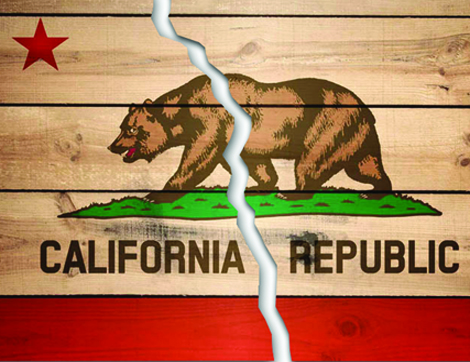
By John Friend
Residents in northern California moved in early September to form their own state separate from the Golden State, specifically citing the need for local control, smaller government and gun rights in their formal declaration of secession. It’s part of a growing number of movements across the United States that not only seek to break away from oppressive state governments but even to leave the U.S. entirely.*
On September 3, the Siskiyou County Board of Supervisors took the first step in a long journey aimed at withdrawing from the state of Calif. The Board of Supervisors voted 4-1 in support of a citizen-led initiative “to commence the Constitution’s Article 4, section 3 process of carving out a new state from an existing state just like the state of Maine was created out of the state of Massachusetts,” Supervisor Marcia Armstrong told this reporter.
“This was a grassroots citizen movement,” Ms. Armstrong explained. “A resolution was placed on our agenda by a group of citizens for discussion. After dialogue, we made it a declaration to be read into the record of the state legislature.”
Mark Baird, a rancher in Siskiyou County who also serves as president of Scott Valley Protect Our Water and vice president of the Siskiyou Water Users Association, is a leading proponent of withdrawing from the state of Calif. with the long-term goal of forming the state of Jefferson, which would consist of rural counties in northern Calif. and southern Oregon.
“We have to have government that’s local, understands our issues and has empathy” for those affected, Baird explained during the Board of Supervisors meeting.
Rural residents of northern Calif. and southern Oregon have long sought to establish an independent state called Jefferson. Efforts to form the state of Jefferson go back to the 1940s, and have gained momentum in recent years under the leadership of Mr. Baird and many others who are concerned about the future of their rural communities. Most of the residents in rural northern Calif. have deep connections to their communities, farms, and ranches.
“Many of my constituents are descendants of the California pioneers who came here in the 1850s during the Gold Rush,” Armstrong explained to this newspaper. “Many remain on those very same ranches established by their ancestors and are 5th and 6th generation Californians.”
Rural folk in northern Calif. feel disconnected from the Calif. state government centered in Sacramento, which they contend is often dominated by more heavily-populated urban areas in the southern part of the state. They say that their interests are not being properly represented or championed in Sacramento. Water rights issues, the rural fire prevention fee, lack of representation in Sacramento, and other burdensome state regulations imposed on rural residents top the list of grievances of those wishing to withdraw from the state.
Gabe Garrison, a local resident, expressed a popular sentiment: “Many proposed laws are unconstitutional and deny us our God-given rights. We need our own state so we can make laws that fit our way of life.”
Ms. Armstrong explained that her vote in support for the declaration to withdraw from the state of Calif. was based on five key factors: over-regulation by the state government, restrictions on rights specifically protected by the U.S. Constitution particularly relating to the Second Amendment, inadequate representation of rural residents in Sacramento, the dominance of regional boards and associations over locally elected government institutions, and the need to return to limited government.
“The ultimate goal of our initiative is nothing less than state hood,” Mr. Baird stated to this reporter. “Americans and particularly pioneers and westerners are known for doing difficult things. My wife and I built our ranch with our own…hands. We built our own house. We grow our own food. We built our business, against a regulatory environment which has done everything in its power to stifle free enterprise and the American Dream.”
“People in Southern California tend to dismiss this as unachievable,” Baird continued. “Let me remind you that this very thing has been done four times in the history of our country. Also, remember a very small group of individuals with the grit to stand up for what is right founded the United States of America.”
Mr. Baird and others working for the establishment of the state of Jefferson are seeking to “start over” and “get back to the basics of good government.”
“We are a moral people and we need a moral government,” explained Baird, who has expressed outrage at some of the extremely liberal policies coming from Sacramento, including the Calif. state law recently passed granting transgender children the right to choose which bathroom they wish to use regardless of their biological gender.
“People in the south do not understand who we are much less how we live,” Mr. Baird went on to say.
Siskiyou County’s declaration for withdrawing from the state of Calif. must be approved by both the state legislature and the U.S. Congress. Readers of AFP are encouraged to visit California Rural counties for equal representation to learn more about this initiative.
“We must do this or we will perish,” Mr. Baird concluded. “Many of us are in dire straits. We must win in order to improve our lives and the lives of our families.”
* While the Jefferson plan only calls for seceding from the states of Calif. and Oreg., there are currently proposals in 15 states to secede from the U.S. entirely. From Vermont all the way to Alaska, different grassroots groups have mobilized to get out from under the heavy hand of the federal government. This includes the Cascadian Independence Project, which seeks to form a new country out of British Columbia, Washington, Oreg., parts of southern Alaska and northern Calif., as well as the League of the South, which is a Southern nationalist organization that seeks a “free and independent Southern republic.”
John Friend is a writer who lives in California.


